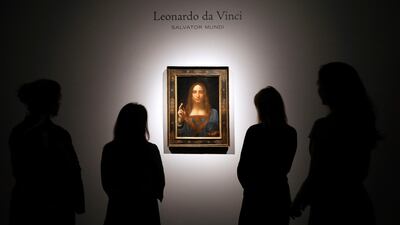There is the painting itself, of course.
But the news that Leonardo Da Vinci's Salvator Mundi is coming to Abu Dhabi, as revealed on Thursday, is about much more than just where to hang this latest piece of artistic real estate.
The most expensive in the world, and the only Da Vinci in private hands. Perhaps it will hang next to the same artist's La Belle Ferronnière, already one of the most popular exhibits at Louvre Abu Dhabi.
For a museum newly arrived on the world cultural scene, the painting, sold at Christie’s New York only last month, is a game changer.
The first lesson is that everyone loves a Leonardo. From the opening day, the postcard of La Belle Ferronnière was one of the top sellers at the museum's gift shop.
Now imagine the impact of Salvator Mundi.
You’ve seen the painting. Now buy the t-shirt. And the mug, and the fridge magnet, the notebook, the tote bag and, of course, the postcard.
____________
Read more:
Louvre Abu Dhabi to be first museum in Middle East to show a Leonardo Da Vinci painting
Louvre Abu Dhabi virtual tour: the objects you shouldn't miss
____________
The marketing possibilities are endless, and potentially highly lucrative. A 2016 survey of American museums showed that sales in the gift shop accounted for eight per cent of income, more than admission tickets or any other single source of revenue other than endowments and other gifts.
Another survey in the US, for the Museum Store Association in 2011, found that sales could reach as high as US$8.2 million (Dh30 million) for a single gift shop.
For Anna Somers Cocks, the chairman of The Art Newspaper, the arrival of Salvator Mundi could be as significant as the Mona Lisa is for its Parisian counterpart.
"The Louvre in Paris gets 7.2 million visitors annually and they estimate 80 per cent of them come to see the Mona Lisa in the first place," she says.
The city now has "an emblematic building with an emblematic object. People will say 'let's go to Abu Dhabi to see this amazing museum and this amazing painting'.”
Exactly when the painting will arrive in Abu Dhabi is still to be revealed, as is how long it will stay here.
The museum has revealed nothing more than a single tweet in the three languages, simply stating: "Da Vinci's Salvator Mundi is coming to Louvre Abu Dhabi."
At the same time, the New York Times on Thursday claimed that the purchaser of Salvator Mundi is a Saudi prince, Bader bin Abdullah bin Mohammed bin Farhan Al Saud.
The newspaper says Prince Bader is a close friend of the Saudi Crown Prince, Mohammed bin Salman and that he will pay for the work in six, monthly, instalments, each over US$58 million.
The newspaper says it confirmed the purchase after seeing records relating to the sale. It describes Prince Bader as “such an unknown figure that executives at Christie’s were scrambling to establish his identity and his financial means".
Unusually for an old master, the Salvator Mundi, or 'Saviour of the World' was placed in an auction of modern art, including a work by Andy Warhol.
The gamble paid off. After 20 minutes of bidding, the hammer came down with a new world record for a work of art, surpassing the $179.4 million paid for Picasso's Women of Algiers, also at Christie's, in 2015.
That huge price tag will be part of the allure of the painting when it comes to Abu Dhabi, says Ms Somers Cocks, and will be a major draw for some overseas visitors.
“Chinese tourists will want to come to see the world’s most expensive work of art,” she says.
Whatever the deal to show the painting, it is “a clever move,” she adds.
“If it stays there for a long time, it becomes an ultra-powerful object."
The Mona Lisa, she points out, only became internationally famous after it was stolen from the Louvre in 1911. Its celebrity, she says, is not necessarily "related to the beauty of the art".
Salvator Mundi is believed to have been painted in around 1500, possibly as a devotional object for Louis XII of France. It shows Jesus in 16th century dress, with his right hand raised in blessing, and the left holding a crystal globe, representing his divine role as saviour.
____________
Read more:
____________
It later ended up in the collection of Charles 1 of England, but then disappeared until 1900, when it was attributed to a follower of the artist.
In 1958 it was sold for just £45 (Dh221), then again in 2005, for US$10,000 when it had been heavily overpainted.
After restoration it was finally confirmed by experts in 2011 as a genuine Da Vinci, and one of less than 20 surviving paintings by the Renaissance master.
Its last owner was a Russian billionaire, Dmitry Rybolovlev, who paid $127.5 million for it in 2013.


